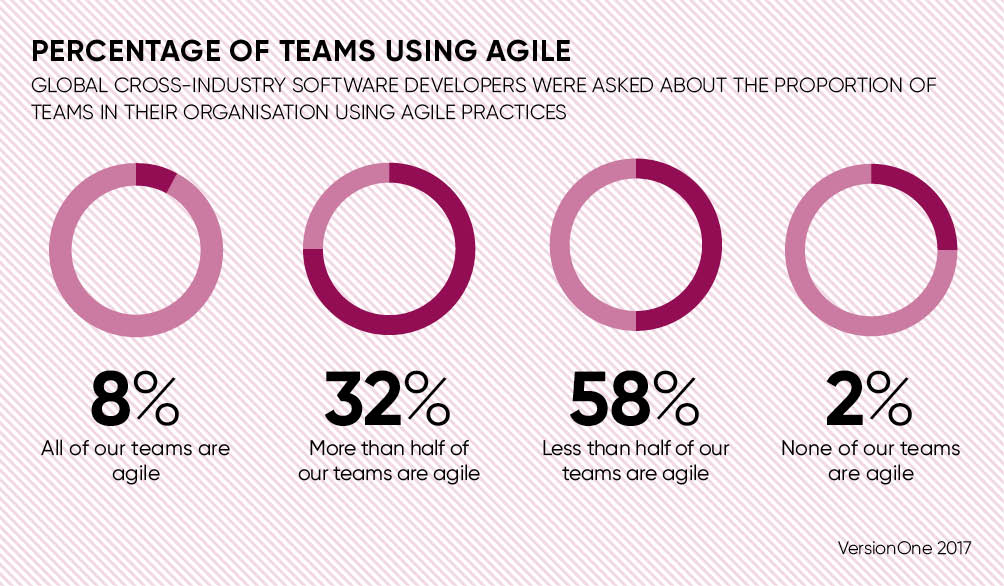In the new age of digital business, it is widely acknowledged that software runs the world. From cottage industry cake bakeries to oil rigs, software intelligence underpins and controls the flow of daily operations in every vertical.
If we accept this core truth, then can we now extend the methodologies used to construct software programs and apply them to business workflows? Specifically, can agile in code translate to agile in business?
In basic terms, the agile approach and methodology embodies the notion of being able to fail fast and recover even faster in a world that accepts continuous change as standard. Agile places value on individuals and interactions over processes and tools. It is a mindset that is open to a potentially unlimited number of practices. Agile accepts that what works today may not work, as effectively at least, tomorrow.

Wider subsets and close relatives of agile also exist. Kanban derives from a supply chain inventory approach designed for what we can call lean or just-in-time manufacturing. Kanban originated on automotive assembly lines at Toyota, but it can be applied in a cake bakery or on an oil rig, to use the above deliberatively random and incongruent examples.
Also sharing agile DNA, scrum is a management and complexity control process where smaller chunks of work can be approached in fixed duration sprints. Scrum sprints are driven by scrum masters who organise daily team member huddles called, somewhat unsurprisingly, scrums. Wider still across the agile spectrum, there’s the people and roles-focused crystal. There’s also eXtreme programming, which champions peer reviews across pairs. All form part of the agile universe in some way.
“Agile is a solution to the completely flawed way of working that we currently use in most projects. The so-called waterfall methodology, where we work towards a massive pre-specified goal, awaiting lots of dependencies along the way and only review if we’ve got it right or wrong at the end, is broken at best and was maybe always a bad idea,” says Daniel Rowles, chief executive of TargetInternet.com, a firm that specialises in digital marketing and e-learning techniques.
At its heart is a way of getting stuff done that is suited to the fast pace of change we have to deal with in business today
Mr Rowles explains that the great thing about agile is that it is a set of principles rather than a strict set of procedures. It can be implemented in a whole range of ways, depending on the challenge at hand and the level of formal processes required. At its heart is a way of getting stuff done that is suited to the fast pace of change we have to deal with in business today.
But as disciplines in their own right, software development and business management are of course different. The inconvenient truth is you can’t just stick agile on to business. Software development can be experimental, segmented away from live business operations and carried out in so-called sandbox environments. Business doesn’t get this luxury quite as often. Perhaps the answer lies in getting business managers and lower-hanging executives to think and act like agile developers.

The issue centres on the fact that, in general, software development can be more strictly codified and compartmentalised than any essentially connected business department or function can be. So how can the specific different elements of agile be applied to a combination of workflow practices that address different value streams and areas of the business? To “get agile”, business needs to blend a variety of these methodologies and come up with a new agility mix.
Matt Candy, vice president and European lead for IBM’s business design division iX, says the main benefits of creating an agile enterprise are broader-based skills and increased engagement across all departments.
“In an agile workplace, employees have more autonomy and purpose, which drives engagement. Collective intelligence is highly valued, as it will always outweigh individual insights. Agile is a fundamental step in creating a high-performing culture because it means people learn from each other,” says Mr Candy.
We can extend agile principles that were initially targeted at software product development to strategy, human resources, finance and marketing or any business function
Chair at the Agile Business Consortium Geof Ellingham agrees that we can extend agile principles that were initially targeted at software product development to strategy, human resources, finance and marketing or any business function. What’s really needed now is agile thinking across all subsets of agile in all applied business scenarios, he says.
“Organisations will get the best out of any aspect of these methodologies once they’ve embedded an agile culture deep in their DNA, then they will tend to draw out the most relevant aspects from any methodology and make it their own,” he says.
The answer, it seems, was staring us in the face all along. As Mr Ellingham suggests, why not tap into the pragmatic attitude at the core of agile and take the best of each? A more agile world awaits, so start limbering up now.




